PLANT PEST

Fire blight
Exotic to Australia
Features: A fast spreading bacterial infection of rosaceous hosts, particularly apple and pear, affecting all parts of the tree
Where it’s from: Asia, Africa, North, Central and South America, Europe and New Zealand
How it spreads: Importation of infected plants or plant propagation material; local spread by wind, rain, insects, birds, vehicles, people, and equipment
At risk: Plants in the family Rosaceae, including apple, pear, hawthorn, quince, loquat, rose.
Keep it out
Fire blight (Erwinia amylovora) is a serious bacterial disease of pome fruit including apple, pear, quince, and loquat. It gets its name from the burnt appearance of affected plants. Symptoms of fire blight infection generally affects all parts of the plants from blossoms and leaves to branches and roots, eventually killing the tree. There is no cure for the infection.
The disease spreads easily and rapidly since it can be spread by wind and rain as well as insects, and by people, vehicles and equipment.
If fire blight established in Australia, many of our pome fruit crops would be at risk.
Importing goods
To keep fire blight out of Australia, never ignore Australia’s strict biosecurity rules.
Import shipments may need to be inspected, treated and certified, so before you import, check our Biosecurity Import Conditions system (BICON).
What to look for
- New shoots and leaves that appear glassy and water soaked with an off-green colouring before turning brown or black.
- Shoots and branches bent into a crook shape at the end.
- Reddish brown streaks can appear in the sap wood beneath the bark.
- Dry twigs, dead branches that appear burnt with dead leaves remaining on the tree.
- Water soaked and dark sunken cankers.
- Bacterial ooze on fruit.


Where to look
Importers
Importation of infected plant material poses the greatest risk of the disease entering Australia.
Growers and home gardeners
Look out for trees with ‘burnt’ leaves, oozing fruit and dry twigs with a crook at the shoot tip.
Plants that can be infected include:
- apple
- pear
- quince
- loquat
- plum
- apricot
- berries and
- amenity hosts such as hawthorn, cotoneaster and firethorn.
What to do
If you think you have found plants with fire blight:
- take a photo
- do not disturb infected plants (this may be as simple as closing the doors on a shipping container or preventing access to an orchard).
